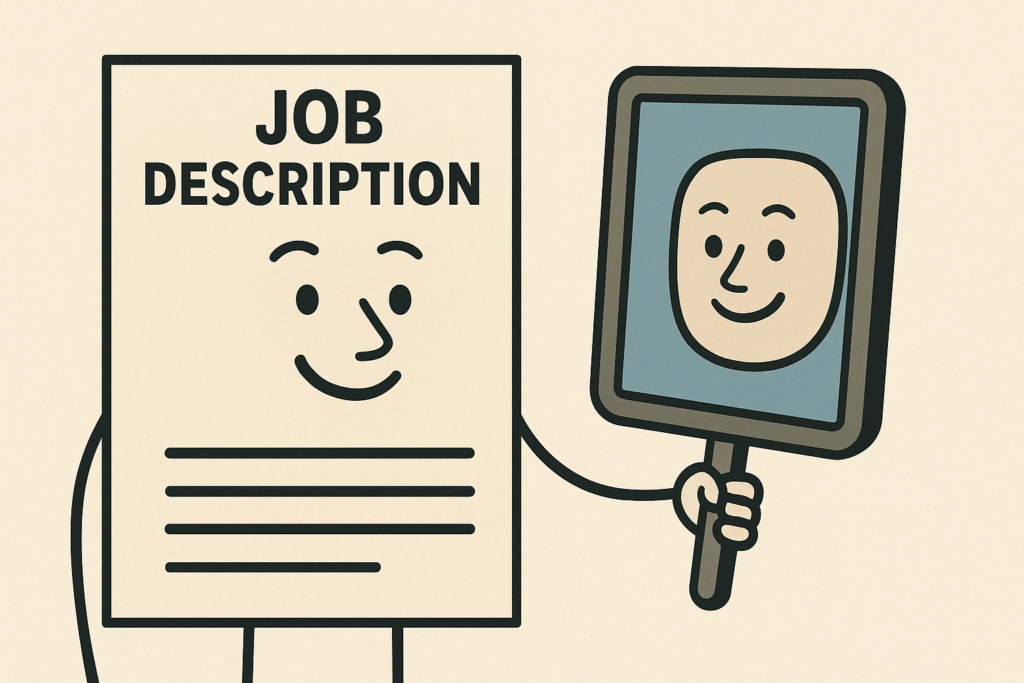- Job Description Process Improvement: How One Workflow Fix Saved 1,200 JDs from Chaos - December 4, 2025
- Affordable Job Description Management Software (That Still Do the Job Right) - November 19, 2025
- AI is Flooding Your Jobs With Unqualified Applicants (We’re Still Figuring Out How to Fix It) - November 18, 2025
If your job description had a voice, it probably wouldn’t say what you think it would. It might whisper, “We don’t really know what we want,” or shout, “We copied this from somewhere else!”
Job descriptions are one of the most public ways your company speaks to the world. And yet, so many of them sound like they were written by a robot intern in 2003. They don’t reflect your values, your culture, or the reality of the job. Worse, they send the wrong message about what it’s actually like to work with you.

Imagine your job description said this out loud:
- “We’re really corporate.” (Because the whole JD is packed with jargon like “synergize,” “drive excellence,” and “stakeholder management”.)
- “We don’t value diversity.” (Because there’s no mention of inclusion or belonging anywhere, and every benefit listed is not one-size-fits-all.)
- “We’re old school.” (Because the requirements list includes things like “10 years’ experience in a fast-paced environment” for an entry-level role.)
- “We don’t know who we are.” (Because the tone of the JD doesn’t match the tone of your brand – or worse, it contradicts it.)
Most hiring managers don’t mean to do this. They’re just busy. So they recycle. Or they Google. Or they write what they think they’re supposed to write instead of just telling the truth about the job.
But here’s the thing: candidates notice.
They might not say it out loud, but they feel it. They feel when a JD feels stiff or fake. They feel when it sounds like someone who’s never done the job wrote it. And they absolutely feel it when there’s no heart behind the words.
Here’s how to fix it:

- Write like a human. If you wouldn’t say it in a 1:1 convo, don’t put it in your JD.
- Start with one truth about the role. What’s the biggest challenge or opportunity? Lead with that.
- Use “you” more than “we.” Make it about the candidate. What they get to do, build, lead, create.
- Ask the team who already does the job. Their language will be more real than anything from HR.
- Match your tone to your culture. If you’re casual, be casual. If you’re formal, be formal. Just be consistent.
Remember, your job description isn’t just a list of tasks. It’s a story. It should show people who you are, not just what you want. And if it had a voice, it should sound like someone they want to work with.
Why I Wrote This
Too many job descriptions sound like strangers talking to strangers. At Ongig, we help teams create job content that actually sounds like you. Our job description software makes it easy to write, edit, and scale JDs that attract the right people. Request a demo to see how we can help.
FAQs
How can I test if my JD sounds human?
Read it out loud. If it sounds weird coming out of your mouth, it probably needs a rewrite.
What’s the biggest turn-off in a job description?
Vague buzzwords and unrealistic requirements. Be clear and honest instead.
How often should we update our job descriptions?
At least once a year – or whenever the role changes. Keeping them fresh matters.
What tools help improve JD tone?
Ongig, of course. Also tools like Hemingway App or Grammarly can help simplify language.
Can tone affect who applies?
Absolutely. Friendly, inclusive tone attracts broader, more engaged talent.
